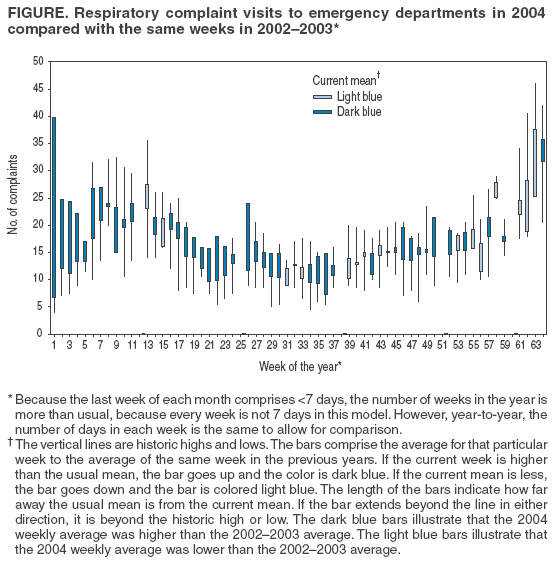 |
|
|
|
|
|
|
| ||||||||||
|
|
|
|
|
|
|
||||
| ||||||||||
|
|
|
|
|
Persons using assistive technology might not be able to fully access information in this file. For assistance, please send e-mail to: mmwrq@cdc.gov. Type 508 Accommodation and the title of the report in the subject line of e-mail. Visual Portrayal of Syndromic Surveillance Data by Using High-Low Charting --- Maine, 2004Gwen M. Rogers, A. Valenti Corresponding author: Gwen M. Rogers, Department of Epidemiology and Infection Prevention, Maine Medical Center, 22 Bramhall St., Portland, ME 04102. Telephone: 207-662-2550; Fax: 207-662-6785; E-mail: rogerg@mmc.org. Disclosure of relationship: The contributors of this report have disclosed that they have no financial interest, relationship, affiliation, or other association with any organization that might represent a conflict of interest. In addition, this report does not contain any discussion of unlabeled use of commercial products or products for investigational use. Abstract Introduction: The Maine Medical Center (MMC) Department of Epidemiology began conducting syndromic surveillance on January 1, 2002, by using computerized chief complaints from the emergency department (ED). Objective: Using an electronic spreadsheet and corresponding high-low graph, current patterns of chief complaints are measured against historic rates in real time. Methods: Chief complaints are classified into four syndromic surveillance categories: gastrointestinal, dermatologic, neurologic, and respiratory. They are manually totaled by category, day, and week. Historic high, low, mean, and the mean for the current week are entered into a computerized spreadsheet and graphed. The mean of the current week is visually portrayed within the historic high, low, and mean (Figure). Graphs are returned to EDs monthly, and reviews are conducted when historic rates are exceeded for 2 consecutive weeks. Results: During fall 2002, the Maine Bureau of Health began receiving reports of gastrointestinal illness from sick callers. A foodborne outbreak was confirmed by syndromic surveillance. Syndromic surveillance demonstrated that the 2003--04 influenza season extended longer and peaked at a much higher rate than in previous years. These are just two examples of the usefulness of the system in detecting public health events in an ED with >80,000 visits each year. Conclusion: The syndromic surveillance in this report has the potential to enhance public health surveillance by detecting abnormalities in the volume of chief complaints that are of public health concern. The flexibility and utility of the system is enhanced by its simplicity. Measurement of individual chief complaints allows for variation in case definitions and minimal data manipulation. Use of existing software limits operating costs to person time of approximately 40 minutes daily. Manual calculation is required because of a lack of computerized automation and Monday through Friday staffing; weekend data are not calculated until Monday. Figure  Return to top.
Disclaimer All MMWR HTML versions of articles are electronic conversions from ASCII text into HTML. This conversion may have resulted in character translation or format errors in the HTML version. Users should not rely on this HTML document, but are referred to the electronic PDF version and/or the original MMWR paper copy for the official text, figures, and tables. An original paper copy of this issue can be obtained from the Superintendent of Documents, U.S. Government Printing Office (GPO), Washington, DC 20402-9371; telephone: (202) 512-1800. Contact GPO for current prices. **Questions or messages regarding errors in formatting should be addressed to mmwrq@cdc.gov.Date last reviewed: 8/5/2005 |
|||||||||
|